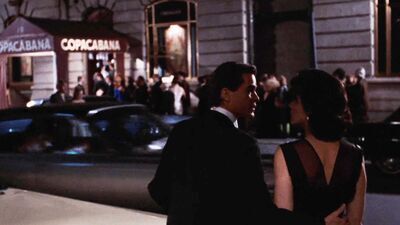“I was born in a crossfire hurricane and I howled at my Ma in the driving rain, but it’s alright now, in fact it’s a gas! I’m Jumpin’ Jack Flash,” Jagger growls, lyrics that encapsulate Johnny Boy’s penchant for causing chaos and destruction wherever he goes. The down-and-dirty rocker articulates Charlie’s magnetic attraction to Johnny Boy which makes him believe he can rescue him from his downward spiral as a way to do his penance.
Scorsese also uses music to construct softer moments, such as his repeated use of “(I Remember) In the Still of the Night” by The Five Satins in “The Irishman.” The romantic doo-wop plays during the wedding of Bill Bufalino’s daughter and the end credits, but its placement in the opening scene is particularly pensive. Once again, Scorsese uses popular music to propel a Steadicam shot, but unlike the glamour and excitement that “Goodfellas” portrays, “The Irishman” cracks open the sorrow and isolation that the mafia way of life brings.
As the camera moves slowly and purposefully through the stark shadows of a crowded retirement home before landing on an elderly Frank Sheerhan slumped in his wheelchair, the soulful ballad takes on a far more somber tone. The Five Satins’ velvety harmonies about teenage love and an overwhelming need to “Hold me again, with all of your might” sound desperate and forlorn, lyrics that are especially poignant for Frank Sheerhan who has had everything he knows and love slip away with time. The swaying rhythm tapers when Frank begins to narrate the events that have led him to this point of loneliness. This gentle serenade has a nostalgic yearning that perfectly accompanies Scorsese’s solemn reflection on aging as a gangster.
Expanding beyond the beloved pop/rock songs of his youth, Scorsese inserts “Intermezzo” from the opera “Cavalleria rusticana” by Pietro Mascagni into the pictorial prelude of “Raging Bull.” Through this soaring composition, Scorsese artfully juxtaposes Jake LaMotta’s past and present, making his fall from grace even more hard-hitting. In slow-motion, Jake LaMotta’s ghostly figure shadow boxes, his feet bobbing between the swirling fog that obscures the crowd. There is no visible opponent, suggesting that he is his own true adversary. Mascagni’s swelling violins have a mournful yet awe-inspiring timbre that frames the hulking pugalist as a heroic, larger-than-life, but ultimately tragic figure with a balletic talent—making the subsequent scene where he has devolved into a lumpy, angry comedian mocking the vestiges of his legacy especially bleak.

